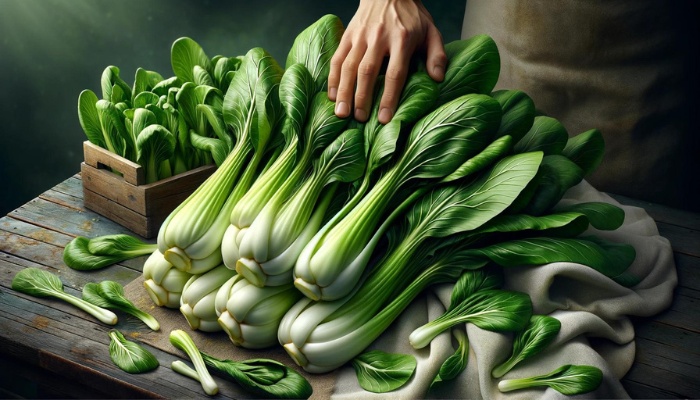To grow bok choy in your square foot garden, start by planning your layout and ensuring the soil is rich in organic matter with a pH of 6.0 to 7.5.
Select high-quality seeds, considering germination rates and disease resistance. Plant them 1 inch apart in well-draining soil, and maintain a consistent watering schedule, adjusting to the plant’s growth phase.
Implement pest control early on to protect your crops. Harvest your bok choy when the stalks are firm and the leaves are dark green, preferably in the early morning for the best flavor.
Planning Your Square Foot Garden
Soil preparation is the foundation of a thriving garden. You’ll want to ensure the soil in each square foot is rich in organic matter, with a pH level ideally between 6.0 and 7.5.
Incorporating compost or well-rotted manure can significantly enhance soil fertility, providing the essential nutrients bok choy needs to flourish.
Equally important is the choice of location. Bok choy prefers a spot that receives full to partial sunlight, requiring at least 4 to 6 hours of direct sunlight daily.
However, in warmer climates, choosing a location that offers afternoon shade can protect your bok choy from excessive heat, which could otherwise lead to bolting before the plant matures.
Additionally, ensure your garden is situated in an area with good air circulation to prevent the onset of fungal diseases, which bok choy can be prone to in humid conditions.
Selecting Your Bok Choy Seeds
The bok choy variety you choose will significantly influence both the growth process and the ultimate harvest. Seed germination, a critical phase in your bok choy’s life cycle, depends heavily on the variety choice.
Different varieties have distinct germination rates and temperature tolerances, making some better suited for your specific climate and gardening conditions.
When selecting seeds, it’s essential to consider the maturity rate of the bok choy variety. Some mature within 30 days, which is ideal for short growing seasons, while others might take up to 70 days and are better suited for areas with longer growing periods.
Disease resistance is a key trait to look for in seed varieties. Varieties bred for resistance to common ailments can significantly reduce the need for chemical treatments and increase the success rate of your crop.
Lastly, don’t overlook the importance of seed viability and quality. High-quality seeds have a higher germination rate, ensuring that your effort in preparing your square foot garden isn’t wasted.
Opt for reputable seed suppliers, and consider organic seeds to guarantee the purity and genetic quality of your bok choy plants.
Planting and Spacing Tips
Work the soil until it’s loose and well-draining, incorporating organic matter to both improve texture and add nutrients. Bok choy thrives in slightly acidic to neutral soil, with a pH between 6.0 and 7.5.
When planting, space your seeds about 1 inch apart in rows that are 18 to 24 inches apart. This spacing allows each bok choy plant enough room to mature while maximizing your square foot garden’s yield.
After sowing, lightly cover the seeds with soil, ensuring they’re no more than a half-inch deep.
Pest control is integral from the start. Begin by selecting disease-resistant seeds, and practice crop rotation to prevent soil-borne diseases.
Use natural predators and barriers to keep pests at bay, and always inspect your plants regularly for early signs of infestation.
By following these planting and spacing tips and focusing on soil preparation and pest control, you’re setting the stage for a successful bok choy harvest.
Daily Care and Maintenance
Ensuring your bok choy plants receive consistent, adequate watering is essential for their development and overall health. Your watering schedule should adjust to the plant’s growth phase and the climate.
Initially, keep the soil moist but not waterlogged to encourage germination. As bok choy matures, reduce frequency but increase depth of watering to promote root development.
This balance prevents both underwatering, which can stress the plant and decrease yield, and overwatering, which risks root rot and fungal diseases.
Pest control is equally vital. Bok choy attracts a range of pests, including aphids, flea beetles, and cabbage worms. Regularly inspect your plants for signs of infestation.
Introduce natural predators like ladybugs, apply neem oil for a nontoxic treatment, and use floating row covers to physically block pests. Remember that early detection and action can save your crop from significant damage.
Consistent, diligent care, focusing on a tailored watering schedule and strategic pest control, ensures your bok choy thrives.
Harvesting Your Bok Choy
Knowing when and how to harvest your bok choy is important for maximizing both its flavor and nutritional content. Typically, bok choy is ready for harvest 45 to 60 days after planting, but you’ll want to watch for the telltale signs that it’s at its peak.
Look for firm, crisp stalks and lush, dark-green leaves. If you notice any yellowing or flowering, it’s imperative to harvest immediately, as these are signs of overmaturity, which can compromise flavor.
When harvesting, use a sharp knife to cut the bok choy at its base, leaving about an inch above the soil line. This technique encourages regrowth for a potential second harvest.
Early morning is the best time for harvesting because the cooler temperatures help retain the plant’s natural sugars, enhancing its flavor considerably.

